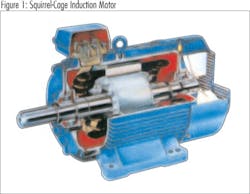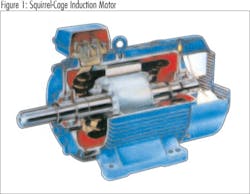Back to Basics: How to Increase Pump Motor Efficiency
By Allan R. Budris
Most pumps are driven by induction motors, which means that motors contribute to the overall pumping system efficiency. This column is dedicated to exploring the key motor efficiency issues that are under the pump user’s control. In a typical industrial site, motor driven equipment accounts for two thirds of the electric energy consumed.
Electric motors have evolved over the past 150 years. Although there are various motor constructions to choose from (such as DC or synchronous), the AC cage induction motor is by far the most widely used in industry. It is both rugged and reliable. It is also the preferred choice for most variable speed drive applications. Simplicity, low cost, high reliability, fairly high efficiency, coupled with ease of manufacture, make it the most widely used type in most parts of the world.
Figure 1 shows the typical induction motor arrangement, with three sets of stator windings arranged around the stator core. The rotor has conductors, which are a cage of copper or aluminum bars and short-circuiting end rings. There are no electrical connections to the rotor. Bearings are normally grease lubricated ball bearings, except for very large motors. Oil mist can greatly increase motor bearing life. Three phase current will start induction motors, which are used for all but the smallest industrial applications (below 2 hp). Single phase motors need some other means to start the motor, such as brushes, or split-phase (using a capacitor during starting).
Motor Efficiency Issues
Although the energy lost to pump inefficiency and control valve pressure drops are usually much greater than the energy lost to motor inefficiency, it is not insignificant. Optimizing pump motor efficiency can provide real life cycle cost savings over the life of the pump/motor. The key factors that impact the efficiency of an induction motor are:
- Motor Relative Load (Motors that are oversized and under-loaded)
- Motor speed (numbers of poles)
- Motor Size (Power Rating)
- Motor Class: Standard Efficiency vs. Energy-Efficiency vs. Premium-Efficiency
Motor Part Load Efficiency
The efficiency of an induction motor changes with the relative load on the motor, compared to the motor rating, as shown in figure 2. Down to a motor load of about 50%, the efficiency of most motors remains relatively flat, even peaking around 75% load for some motors. Motors should only be operated below 50% load for short periods, and not be operated below 20% of the rated load. Therefore, when trimming impellers or operating pumps back on their head-capacity curves, the impact on the motor relative load should be evaluated.
Motor Speed
Figure 2 also shows the impact of motor speed on the maximum obtainable efficiency, with four pole motors (nominal 1,800 RPM) achieving the highest efficiency, and two pole (nominal (3,600 RPM) motors giving the lowest efficiency. So, even though a nominal 3,600 RPM pump may be more efficient (and have a lower initial cost) than an 1,800 RPM pump, the 1,800 RPM motor would be more efficient, plus the 1,800 RPM pump would typically have a lower NPSHR and Suction Energy, not to mention a longer life. It should also be noted that the rated motor power size has an impact on motor efficiency, with larger motors being more efficient than smaller motors.
Induction Motor Speed
The synchronous speed of an induction motor can be calculated using the following formula:
n = 120 * f / p
Where:
n = speed in rev/min
f = supply frequency (Hz)
p = number of motor poles (min. = 2)
To control the motor speed without the use of external mechanical devices, it is therefore necessary to control the supply voltage and frequency. Some motors may also be manufactured with multiple windings (number of pole sets) to achieve two or more discrete speeds
Induction motors do not run at quite the synchronous speed - they operate slightly slower (-1% to -3% at full load) as the load is increased. The difference between actual and synchronous speed is called slip. Slip tends to be smaller for newer energy efficient motors, than older standard efficiency motors. This means that “energy efficient” motors run slightly faster for a given load.
High Efficiency Motors
Figure 3 is an example of the efficiency gains possible when an old standard efficiency motor is replaced with a new “High Efficiency” or “Premium Efficiency” motor. As mentioned above, high efficiency motors also operate with less slip which yields slightly higher speed, and therefore, slightly higher pump head and flow.
It may, however, be difficult to justify premium efficiency motors in some (flow control) applications, due to the resulting higher speed (and pump flow), unless the current motor is also very lightly loaded (operating at lower efficiency). The few percentage points of peak motor efficiency that can be gained might be off-set by the additional required throttling due to the slightly higher flow rate. Since the pump shaft input power is proportional to the cube of the speed, simply replacing an old motor with a new, premium efficiency motor will not necessarily reduce energy consumption.
On the other hand, if a little more head and flow from the pump is a good thing (the pump may not have to operate quite as long to empty a sump), replacing an old standard efficiency motor with a high or premium efficiency motor may be justifiable.
Motor Power Factor
Another issue that comes into play with the performance of an induction motor (which has an indirect impact on energy cost), is something called “Power Factor”. Some utilities charge customers a “surcharge” for low power factors. The line losses caused by the higher current required from low power factors also causes real energy losses. Like the motor efficiency, the motor power factor also decreases with reduced motor load, but it is normally fairly flat to around 50% load.
The definition of the Power Factor is:
- Phase shift (delay) of Current sine wave from Voltage sine wave, which produces less net power.
- Shift caused by amount of motor magnetizing current required
PF = Pi / KVA
Where:
KVA = V x I x (3)0.5 / 1,000
The below formula shows how the power factor impacts the motor input power (kW), for 3 phase motors. Note that the lower the PF (the greater the I-V phase shift), the lower the input power, for a given input voltage and current).
Pi = V x I x PF (3)0.5 / 1,000
Where:
Pi = Three-phase input kW
V = RMS voltage (mean of 3 phases)
I = RMS current – amps (mean of 3 phases)
PF = Power factor as a decimal
Although the PF does not directly impact the motor efficiency, it does impact line losses as mentioned above. There are, however, ways to increase the power factor, which are:
- Purchase motors with an inherently high power factor.
- Do not select over-sized motors (the power factor decreases with reduced motor load)
- Install power factor correction capacitors (Motor running capacitors*) in parallel with motor windings
- Draws leading current which offsets some lagging current.
- Can increase full load PF to 95% (Max.)
- Convert to a Variable Frequency Drive
- *Motor Running Capacitors are one of the more popular methods to increase motor power factors, and has the following list of benefits:
- Increase Power Factor
- Reduce reactive current flow from electric utility through cables and motor starters
- Less heat dissipation and kW losses (3% of motor demand)
- Savings potential increases as motor load decrease, and PF drops below 60%-70% (10% savings possible)
- Reduces utility PF penalty charges
- Increase total system capacity
- Intelligent Electric Motor Control
- Variable frequency drives
Higher Voltage
Another way to increase the motor efficiency is to operate with higher voltage. The higher the voltage, the lower the current, and, therefore, the lower the line losses. However, higher voltages do increase VFD costs and are more dangerous to work with.
Conclusions
So when attempting to reduce pump system energy costs, do not overlook the motor efficiency and the above factors that impact it.
WW
About the Author: Allan R. Budris, P.E., is an independent consulting engineer who specializes in training, failure analysis, troubleshooting, reliability, efficiency audits and litigation support on pumps and pumping systems. With offices in Washington, NJ, he can be contacted via e-mail at [email protected].
More WaterWorld Current Issue Articles
More WaterWorld Archives Issue Articles



